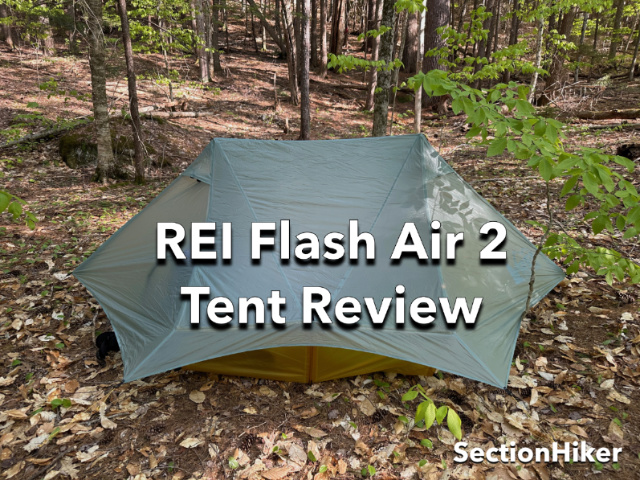
The REI Flash Air 2 Tent (substantially revised for 2023) is a two-person, single-wall trekking pole bikepacking/ backpacking tent that weighs 2 lbs 4.5 oz on our digital scale. It was two doors and two vestibules and comes with 2 black collapsible poles to pitch the tent with if you don’t use trekking poles. Priced at $399, the Flash Air 2 is very easy to set up with a spacious interior – even for tall people. Being a single-wall tent, the bathtub floor and the rainfly are connected, making it easy to set up dry even if it’s raining. The tent’s ventilation, outfitting with line loc tensioners, reflective guylines, and vestibule space make this an excellent value for an entry-level ultralight backpacking and bikepacking tent.
Unfortunately, REI completely botched the Flash Air 2 product description on its website, apparently cutting and pasting the descriptions of multiple tents together, so I hope you’ll find this review clarifying. I honestly think the Flash Air 2 is a very nice shelter and I really like the fact that it’s competitively priced ($399) so that people without a trust fund can afford it. Ultralight backpacking was never meant to be expensive and elitist and I’m appalled that it’s become just that.
Specs at a glance
- Size: 2 person
- Type: Single-wall
- Structural: Trekking Pole Tent
- Published Minimum Trail Weight: 2 lbs 6.5 oz
- Actual Minimum Trail Weight: 2 lb 4.7 oz includes 2 required “gold” poles
- 2 Optional Trekking Pole Replacement Poles included (4.5 oz/pair)
- Minimum number of stakes to pitch: 6, recommended 8
- Doors: 2
- Actual Bathtub Floor Dimensions: 86″ x 50/42″ (L x W head/foot) inches
- Vestibule Volume: 28.72 sq ft
- Peak Height: 47 inches
- Seam-taped: Yes
- Fabric: 20D ripstop nylon
- Hydrostatic head: NA
The REI Flash Air 2 is a 2-person trekking pole tent with 2 doors and two vestibules so occupants can have their own entrance/exit and vestibule gear storage area. The tent comes with two sets of two poles: a black set that is inserted into poles sleeves at the top of the vestibules and that can be used to erect the tent if you don’t have trekking poles, and a two-pole gold set that is used on the ends to increase the depth of the bathtub floor and create more room under the rainfly above the head and feet.

Being a single-wall tent, the bathtub floor and the rain fly are sewn together and set up simultaneously. This is very easy to do with the Flash Air 2 because it has a rectangular-ish floor plan, wider at the head end. You simply stake out the corner guylines on a 45-degree angle, insert the poles into the vestibules, and tighten the pitch all around using the line loc tensioners on the tent’s guylines. Since the bathtub floor and rainfly are a single unit, you can set up this tent in the rain and it will stay dry inside.

The tent has 2 large side vestibules that have plenty of room for gear storage that does not interfere with entry and exit. Both vestibule doors have two-way zippers and velcro patches along the length, so you can create a top transom for airflow even when they’re closed. They also have kickstand peak vents that can be opened to help release the warm air and moisture that can accumulate in the ceiling, particularly when the vestibule doors are zippered shut, which can exacerbate internal condensation.
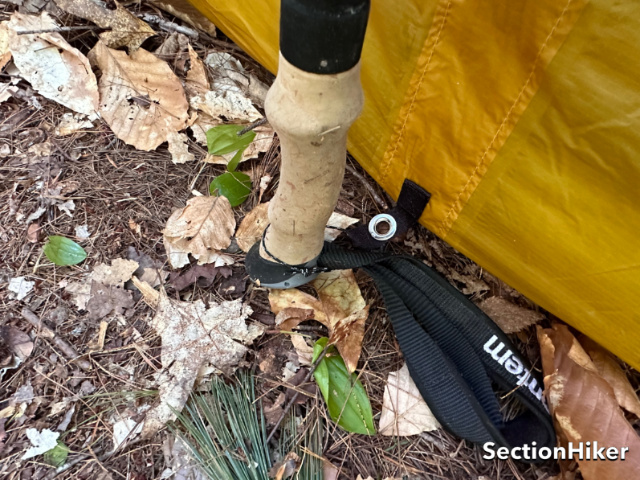
The tent comes with two optional black collapsible tent poles that can be used instead of trekking poles to pitch the tent. These are handy if you’re a bikepacker or you don’t use trekking poles. They’re also handy if you’re a base-camper that does use trekking poles because it means you can set up the tent and then go hiking with your poles without having to take down and set up the tent each time you leave/return. For purposes of packability, the longest segment on the black shock-corded poles is 16″ which will fit in most bike frame bags or panniers, although they might not fit horizontally in smaller ultralight backpacks if that’s how you prefer to pack your tent poles.

If you use trekking poles to set up the tent, the tips should be oriented up and slot into reinforced sleeves in the peaks of the vestibules. The same is true if you use the black pole set. The handle end of the trekking poles is held in place close to the side of the bathtub floor with a loop of cord. If you use the black poles, the base of the poles slots into a side grommet so they won’t slip out at night.
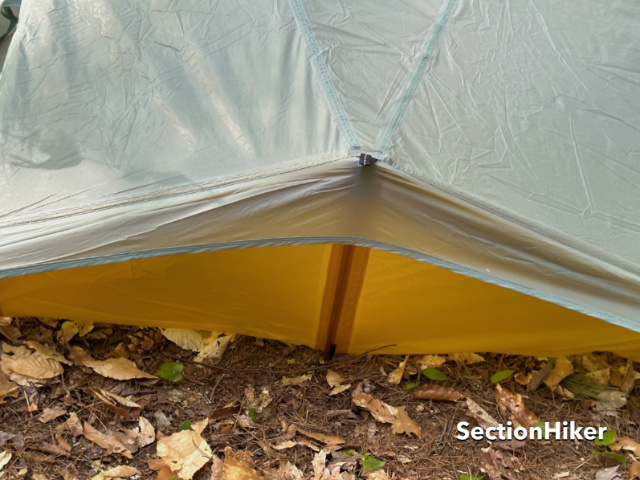
The tent also comes with two short (16 and 1/4″) gold-colored aluminum poles. These slot into reinforced sleeves and grommets at the head end and foot end of the tent. They help create more space above the head and the feet inside the tent and help to keep the walls of the bathtub vertical. They serve the same function as the pitchlocs used by the tent manufacturer Tarptent. Once inserted, these gold poles are VERY difficult to remove and I suggest you leave them in the tent permanently rather than struggle with them (I still can’t get one of them out). They don’t affect packability that much. They only weigh 0.6 oz each and aren’t really worth replacing with anything lighter.
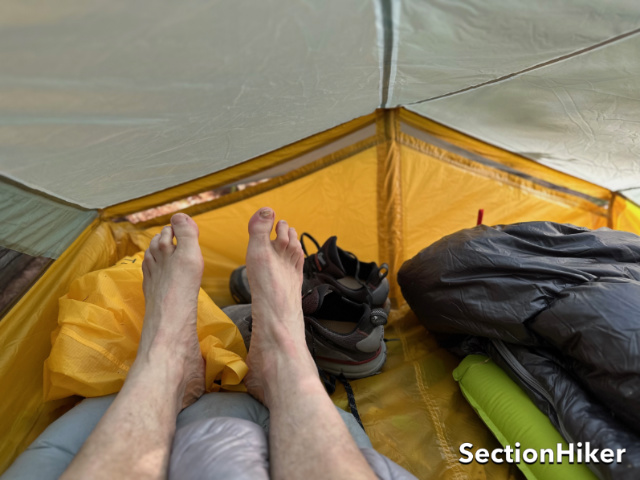
The interior of the tent is very spacious inside and is wide enough to use 2 x 25″ wide pads, as long as they have a tapered mummy shape. The tent is also 86″ long (we always measure the inside of the tent), providing plenty of extra space for taller campers or to store clothing and extra gear inside.
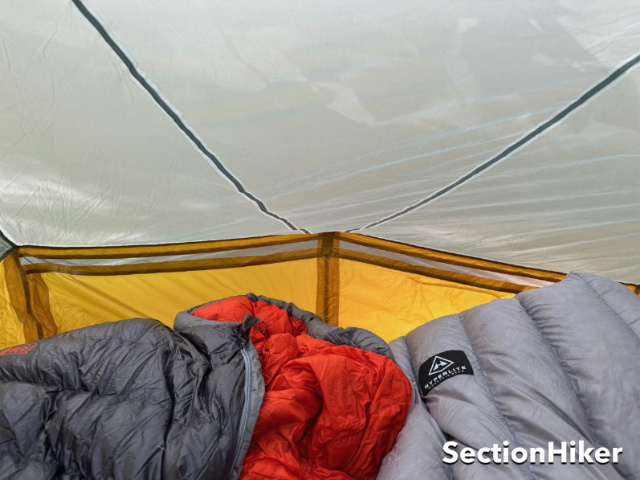
In terms of ventilation, the sidewalls of the tent are solid mesh and there is a strip of mesh located between the ceiling and the side walls at the head and foot ends of the tent. While the latter does provide some ventilation benefit, the real purpose of this mesh is to create some slack between the rainfly and the sidewalls, like a floating floor, that adapts to the terrain if you set up on an unlevel spot. This floating floor feature is a signature feature of the class of single-wall tents called tarptents (not to be confused with the manufacturer named Tarptent), of which the REI Flash Air 2 is a member.

Best Practices
The key to avoiding internal condensation in a single-wall tent is to sleep with the vestibule doors wide open, so there’s only insect mesh between you and the wilderness. To do that, I suggest taking two of the extra guylines included with the tent and tying them to the reinforced loops at the top of the vestibules. This will let you stake out the tent, but roll back both halves of the vestibule, enabling maximum airflow. This is my favorite way to sleep in a tent like this in good weather.


When the vestibules are fully rolled back, there will be some added slack in the big panels above the head and foot ends of the tents. You can eliminate that by adding guy-out lines to the external loop above each of the gold end poles, as shown above. It might also be worth adding a guy-out point to the big ceiling panels since the Flash Air 2 only has guy-out points located along the seams, but that’s a much bigger job than meets the eye and would probably require some sewing and seam-sealing to implement.

Recommendation
The REI Flash Air 2 is an ultralight trekking pole tent with a minimum tent weight of 36.7 oz (on our digital scale) and is made with more conventional materials (20d ripstop nylon) to keep its price reasonable ($399). The interior of the tent is quite large, with plenty of space above the head and toes. The tent sets up fast because the rainfly and bathtub floor are all one piece so you can do it in the rain without getting the interior drenched.
The reason we like the REI Flash Air 2 is that it ticks a lot of boxes for a more traditional pair of backpackers looking to shave some serious weight from their shelter without sacrificing comfort and ease of use, and its wide availability at REI stores will hopefully help to expose a much wider audience to ultralight backpacking. We particularly appreciate that optional tent poles are included (instead of having to buy them separately) to use on trips when you might not bring trekking poles. For folks who have never used non-freestanding or trekking pole-supported shelters before and are curious to try them out, the Flash Air 2 is a good entry point, as the basic setup is simple.
Competition
There really aren’t that many competitive tents to the Flash Air 2, if you only consider single-wall tents, made with more conventional materials, and not more expensive Dyneema DCF:
- The Gossamer Gear “The Two” (23.5 oz) is a spacious single-wall tent with a two-pole design. Made with Sil/PU coated fabric and factory seam-taped, it has less room above the head and foot ends compared to the Flash Air 2 and does not come with any accessory poles (sold separately). It’s also made with 10d fabric which is much more fragile than the 20d ripstop nylon used on the Flash Air 2. $375.
- The Six Moon Designs Lunar Duo Explorer(45 oz) is made with siliconized nylon (silnylon) and is a spacious two-pole, two-vestibule single-wall tent with good ventilation. Unfortunately, it is much heavier and must be seal-sealed before use. $395.
Disclosure: The author owns this product.
SectionHiker is reader-supported. We only make money if you purchase a product through our affiliate links. Help us continue to test and write unsponsored and independent gear reviews, beginner FAQs, and free hiking guides.
